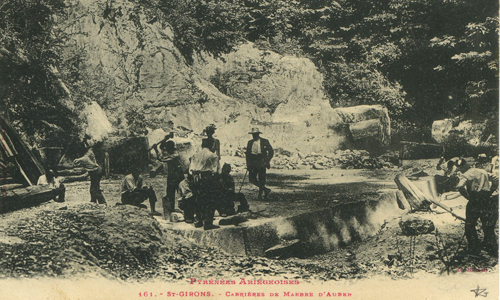|

Présentation :
Les premiers travaux dans la carrière d'Aubert sont datés de l’époque romaine. Les romains exportèrent ce matériau, qu’ils appelaient « marmor celticum », en grandes quantités à Rome et à Constantinople. Plus tard, durant l’époque byzantine, il fut très utilisé pour la décoration du plus grand chef-d’œuvre de l’architecture de l’époque: l’HAGIA SOPHIA d’Istanbul. Après cette période de grande activité, la carrière fut abandonnée et les blocs furent employés pour la décoration de la Basilique de Saint-Pierre, de Sainte-Marie Majeure, de la Basilique de Sainte-Cécile à Rome et de la Basilique de Saint-Marc à Venise.

La carrière fut rouverte au XIXe mais, après une grande exploitation du marbre d'Aubert, notamment dans les années 1920 où il avait été utilisé en grande quantité pour la façade de l'hôtel Roosevelt, à New York, la carrière de marbres dut être une nouvelle fois fermée dans les années 1950, certainement en 1952.
Mais un projet ayant pour but de poursuivre l'exploitation du marbre d'Aubert a été mené en 2012. Ce matériau unique permet de réaliser deux catégories de marbre : le grand antique d'Aubert, qui représente 40 % du marché, et le noir antique, qui représente 60 % du marché.

Peu à peu, le marbre de Moulis (d'Aubert) s'est fait un nom, jusqu'en 2015 où la marque marbre «grand antique d'Aubert» a officiellement été déposée.
Le "Grand Antique", un marbre prestigieux et un rayonnement international :
L'entreprise d'exploitation du marbre va jusqu'à faire rayonner l'Ariège à l'international avec des ventes à Londres, au Japon ou encore à Brooklyn, aux États-Unis.
Plus exceptionnel, le grand antique d'Aubert va être utilisé à New York dans la tour de verre appelée MoMA, construite par l'architecte français Jean Nouvel dans la 53e rue, à Manhattan. Cette tour comprendra des appartements de luxe et plusieurs étages qui seront consacrés à des galeries publiques complémentaires au MoMA, le musée d'art contemporain. Et c'est le français Thierry Despont, qui l'emploiera dans la décoration intérieure.
Caractéristiques du marbre "Grand Antique" :

Ce marbre prestigieux est noir et blanc, ses tonalités créent un contraste très net, qui n’est présent dans aucun autre marbre aux mêmes couleurs.
Extraction du marbre :
Dans le cas du marbre d'Aubert, l'extraction, réalisée par Escavamar, sera au maximum de 200 m3 par an, soit l'équivalent d'environ 600 tonnes. Cette limite permet de limiter l'impact de l'extraction sur la carrière. C'est-à-dire deux à trois campagnes d'extraction par an. Celles-ci se pratiquent au fil diamanté et à la haveuse, dans le marbre aucun explosif n'est utilisé.


Presentation :
The first works in the quarry are dated from Roman times. The Romans exported this material, which they called "marmor celticum", in large quantities to Rome and Constantinople. Later, during the Byzantine period, it was widely used for the decoration of the greatest masterpiece of architecture of the time: the HAGIA SOPHIA of Istanbul. After this period of great activity, the quarry was abandoned and the blocks were used to decorate the Basilica of St. Peter, St. Mary Major, the Basilica of St. Cecilia in Rome and the Basilica of St. Mark in Venise

The quarry was reopened in the 19th century, but after a large exploitation of Aubert's marble, especially in the 1920s when it had been used in large quantities for the facade of the Roosevelt Hotel in New York, the marble quarry had to be closed in the 1950s, certainly in 1952.
But a project aiming to continue the exploitation of Aubert's marble was carried out in 2012. This unique material makes it possible to realize two categories of marble: the great antique of Aubert, which represents 40% of the market, and the black one antique, which represents 60% of the sales.

Gradually, the marble of Moulis made a name, until 2015 when the marble mark "grand antique of Aubert" was officially deposited.
The "Grand Antique", a prestigious marble and an international influence:
The marble exploitation company goes so far as to make Ariège shine internationally with sales in London, Japan or Brooklyn, in the United States.
More exceptional, the great antique Aubert will be used in New York in the glass tower called MoMA, built by the French architect Jean Nouvel in 53rd Street in Manhattan. This tower will include luxury, multi-story apartments that will be dedicated to additional public galleries at MoMA, the Museum of Contemporary Art. And it's the French Thierry Despont, the architect of billionaires, who will use it in interior decoration.
Characteristics of "Grand Antique" marble:

This prestigious marble is black and white, its tones create a sharp contrast, which is present in no other marble in the same colors.
Extraction of the marble :
In the case of Aubert marble, the extraction, realised par Escavamar, will be a maximum of 200 m3 per year, the equivalent of about 600 tonnes. This limit limits the impact of extraction on the quarry. That is to say two to three extraction campaigns per year. These are practiced with diamond wire and the shearer, in the marble no explosive is used.

|